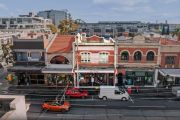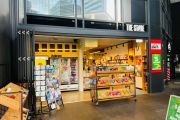
Relics of Australia's industrial past that are still in use today
The controversy over the removal of Australia’s last six wooden escalators – that will leave just one still operational in the world, in Argentina’s Buenos Aires – has turned attention to other historical treasures that are still in daily use around the country.
The escalators are now being ripped out in Sydney, four in Wynyard Station and two at Town Hall, after numerous complaints and incidences of both high heels and guide dog claws becoming stuck in the ridges. Three in Wynyard were installed in 1932, the same year as the Harbour Bridge was opened.
So what other industrial relics of a bygone age are still performing the same functions today?
Lift
Australia’s oldest operating lift, the ‘Birdcage Lift’, in the Sydney Town Hall, opened in 1906. It’s still transporting people up – and down – 111 years later.
Lighthouse
Located at Cape Otway, along Victoria’s Great Ocean Road, the country’s oldest lighthouse was built in 1848 on the cliffs above where Bass Strait and the Southern Ocean surge together. It still has the same original glass lenses and lamps, powered in the early days by oil, kerosene, then electricity. They’re not used so much these days, however, as there’s a solar-powered beacon in front. “But they do still work,” says a spokesperson.
Wool scour
It was started up in 1908, in Blackall in Central West Queensland, as a steam-driven, wool-washing plant to remove dirt, dead skin, pesticides and grass that had become tangled in the wool before it parted company with the sheep. It was the only wool scour in the world with shearing sheds attached. It worked throughout Australia’s golden age of wool and still works today, maintained by a group of volunteers. It gets 11,000 visitors a year.
Railway
The West Coast Wilderness Railway, which runs from Queenstown to Strahan, in Tasmania, across the steepest heavy rail incline in the southern hemisphere, is serviced by some of the original ABT locomotives, with two of the old steamers dating back to 1896 and 1898. ABT Locomotive No. 1 was built in Glasgow and shipped in pieces to Strahan, arriving with no assembly instructions – a huge test for the railway workers who’d never even seen such a locomotive before. “The railway operates on the rack and pinion system and those locomotives are still operational today,” says Ian Terry, senior curator of cultural heritage at the Tasmanian Museum and Art Gallery.
Tram No.1
When the first light rail line re-opened in Sydney in 1997 there had been no trams operational since 1961. As a result, an 1899 scrubber tram had to be taken out of the Sydney Tram Museum at Loftus and put back to work, scrubbing the new rails.
Bridge
The historic Lennox Bridge over the Parramatta River, in Sydney’s west, was built for drays and other horse-drawn vehicles, says Margaret Simpson, one of the curators of the Museum of Applied Arts and Sciences. “But today that’s still going, now with masses of cars using it every day,” she says. The bridge was built in 1839 and recently, while undergoing renovation work, was found to have another bridge buried inside, one built between 1802 and 1804.
Tram No.2
The 1927 W2 class tram that serviced Melbourne for 55 years was converted in 1982 to have a single-level floor and a new entry door to the side, to operate as a part of the Colonial Tramcar Restaurant, serving dinner while travelling through the streets of Melbourne. It was retired in 2006, but one of the 1948 trams, Bela, is still in operation, says general manager Ingrid Marshall.
Pumping station
Sydney’s first electric pump station was built in 1901 to stop raw sewage entering the harbour, and is still in operation today. Sydney Water’s Darren Cash says: “It was built along with the Bondi outfall system that carries the waste water to our Bondi treatment plant.”
Clock
It originally needed rewinding every week, but the oldest public clock in Australia, built in England in 1770 – the year Captain Cook landed at Kurnell – is now rewound electrically. It stands in the main plaza in Sydney’s southern suburb of Cronulla, in a tower built for it during the bicentenary.


















